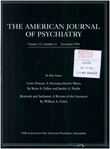Fatigue, sleep disturbance, disability, and indices of progression of HIV infection
Abstract
OBJECTIVE: The authors' objective was to test the hypothesis that fatigue affects the activities and employment of subjects with HIV infection and that indices of immunosuppression and inflammation may have statistical utility in predicting fatigue and sleep disturbance. METHOD: The authors prospectively asked 112 homosexual men (62 HIV- seropositive subjects and 50 HIV-seronegative comparison subjects) to complete a questionnaire on fatigue and sleep disturbance. In addition, hematocrit, WBC count, CD4+ cell number, lactate dehydrogenase, albumin, and total globulin were measured. RESULTS: For HIV- seropositive patients fatigue was significantly more of a problem and interfered more with important activities such as employment and driving than with seronegative comparison subjects. The HIV-infected patients were significantly more likely to be unemployed, to feel fatigued through more hours of the day, to sleep more, to nap more, and to have diminished midmorning alertness. The medical variables could be used to statistically predict fatigue, its interference with daily activities, and employment. CONCLUSIONS: Fatigue and sleep disturbances contribute to morbidity and disability in HIV-infected homosexual men, especially those in CDC stage IV (AIDS-related complex or AIDS). Correlation with measures of immunosuppression and inflammation and comparison between fatigued versus nonfatigued groups suggest the possibility of statistical prediction of fatigue by using these measures. Further study is needed to examine the possibility of eventual specific intervention to clinically treat HIV-related fatigue, sleepiness, and sleep disturbance.
Access content
To read the fulltext, please use one of the options below to sign in or purchase access.- Personal login
- Institutional Login
- Sign in via OpenAthens
- Register for access
-
Please login/register if you wish to pair your device and check access availability.
Not a subscriber?
PsychiatryOnline subscription options offer access to the DSM-5 library, books, journals, CME, and patient resources. This all-in-one virtual library provides psychiatrists and mental health professionals with key resources for diagnosis, treatment, research, and professional development.
Need more help? PsychiatryOnline Customer Service may be reached by emailing [email protected] or by calling 800-368-5777 (in the U.S.) or 703-907-7322 (outside the U.S.).



